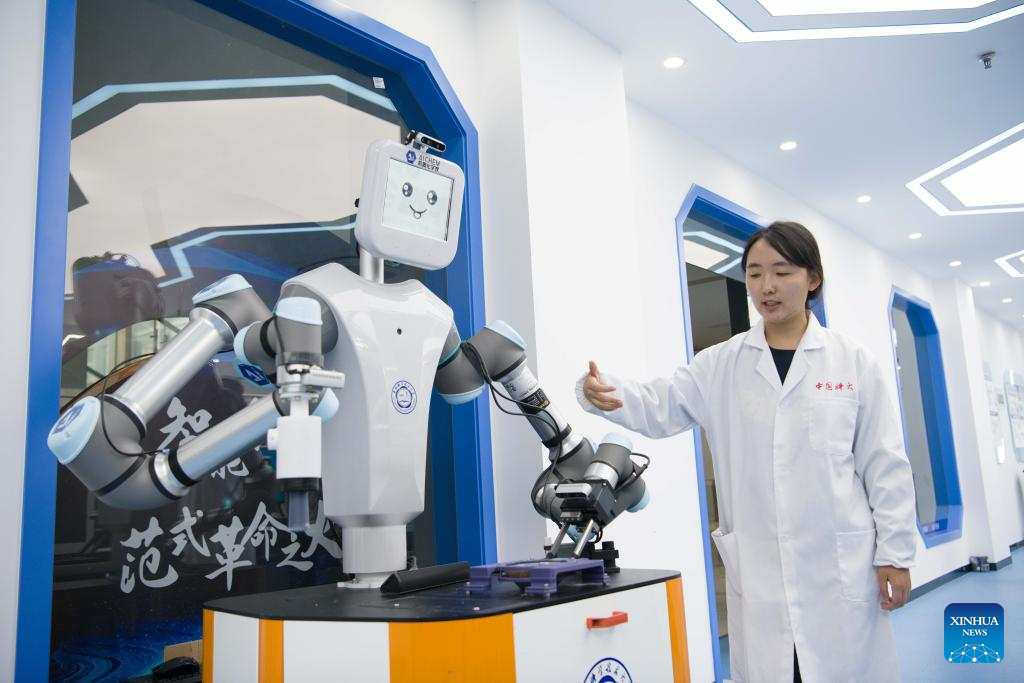
Imagine a lab assistant with the computing and operational power of 10 PhD students, capable of functioning in extreme environments like Mars. This vision has become a reality at the University of Science and Technology of China (USTC), where a team of scientists has developed a robotic chemist named "Luke."

Zhao Luyuan, a 26-year-old PhD student, introduces robotic chemist "Luke" at a lab of the University of Science and Technology of China (USTC) in Hefei, east China's Anhui Province, Oct. 29, 2024. (Xinhua/Zhang Duan)
Built with a sleek white frame, two robotic arms, and advanced components such as a visual system, AI computing platform, and human-machine interaction software, Luke handles delicate tasks like pouring liquids and grinding solids, while independently designing experiments and testing hypotheses.
Compared to humans, Luke can conduct experiments without rest, achieving a precision of 0.1 millimeters in its operations. "What's most remarkable is Luke's capacity for learning and analysis," said Zhao Luyuan, a 26-year-old PhD student who has worked on the project for over three years. "It can learn from 50,000 academic papers in two weeks and verify over 3.76 million experimental formulations in six weeks."
"Robots are becoming effective tools for scientists. Give them a scientific problem, and they can design experiments, complete them with high efficiency and precision, and offer optimized solutions," said Jiang Jun, a professor at the School of Chemistry and Materials Science under USTC.
Since last year, AI chemists developed at the university have achieved significant milestones, including creating catalysts to produce oxygen based on Martian meteorites -- a step toward enabling long-term human stays on Mars. The robots are also researching organic films for currency anti-counterfeiting and cost-efficient coal-to-oil conversion technologies.
According to Jiang, AI is driving a revolution in the field of scientific research, allowing scientists to break through physical and mental constraints, exponentially boost productivity, and accelerate scientific discovery. Robotic chemist projects have become a global research hotspot, drawing interest from institutions in countries such as Britain, Switzerland and the United States.
The development aligns with China's efforts in developing humanoid robots -- a technological convergence of AI, high-end manufacturing and new materials. China aims to establish a preliminary innovation system for humanoid robots by 2025, according to a guideline from the Ministry of Industry and Information Technology. By 2027, the country will see a secure and reliable industrial and supply-chain system, while related products will be deeply integrated into the real economy.
According to a report released at the First Chinese Humanoid Robot Industry Conference in April, the market scale of the humanoid robot industry in China is predicted to reach 75 billion yuan (10.56 billion U.S. dollars) by 2029, accounting for 32.7 percent of the global total.
Despite these advancements, challenges remain. Sun Tao, a professor at the School of Mechanical Engineering at Tianjin University, said that improvements in battery life, decision-making, and natural interaction capabilities are still needed before humanoid robots can be deployed on a large scale.
Yet, for Jiang, the true significance of his robotic companion's emergence is its potential to free human scientists for greater innovation, granting them the time to pursue dreams and discoveries that push the boundaries of imagination. (Xinhua)

86-10-68597521 (day)
86-10-68597289 (night)

52 Sanlihe Rd., Xicheng District,
Beijing, China (100864)

